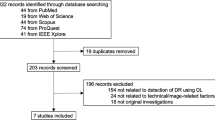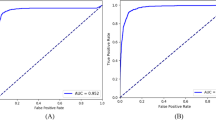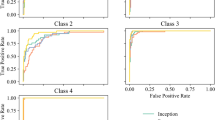Abstract
This study aimed to evaluate the image quality assessment (IQA) and quality criteria employed in publicly available datasets for diabetic retinopathy (DR). A literature search strategy was used to identify relevant datasets, and 20 datasets were included in the analysis. Out of these, 12 datasets mentioned performing IQA, but only eight specified the quality criteria used. The reported quality criteria varied widely across datasets, and accessing the information was often challenging. The findings highlight the importance of IQA for AI model development while emphasizing the need for clear and accessible reporting of IQA information. The study suggests that automated quality assessments can be a valid alternative to manual labeling and emphasizes the importance of establishing quality standards based on population characteristics, clinical use, and research purposes. In conclusion, image quality assessment is important for AI model development; however, strict data quality standards must not limit data sharing. Given the importance of IQA for developing, validating, and implementing deep learning (DL) algorithms, it’s recommended that this information be reported in a clear, specific, and accessible way whenever possible. Automated quality assessments are a valid alternative to the traditional manual labeling process, and quality standards should be determined according to population characteristics, clinical use, and research purpose.
摘要
本研究旨在评估糖尿病视网膜病变 (DR) 公开数据集中的图像质量评估 (IQA) 和质量标准。使用文献检索识别相关数据集, 纳入分析20个数据集。其中, 12个数据集提到执行IQA, 但只有8个数据集明确了所用的质量标准。所报告的图像质量标准因数据集而异, 获取信息往往具有挑战性。研究结果强调了IQA对人工智能模型开发的重要性, 同时强调了明确和可访问IQA信息报告的必要性。研究表明, 自动化的图像质量评估可以有效替代手动标签的方法, 并强调建立基于人口特征、临床使用和研究目的制定质量标准的重要性。总之, 图像质量评估对人工智能模型的开发非常重要, 然而, 严格的数据质量标准不能限制数据共享。鉴于IQA对于开发、验证和实现深度学习(DL)算法的重要性, 建议尽可能以清晰、具体和可访问的方式报告这些信息。自动化质量评估是传统手工标记过程的有效替代方案, 质量标准应根据人口特征、临床应用和研究目的来确定。
This is a preview of subscription content, access via your institution
Access options
Subscribe to this journal
Receive 18 print issues and online access
$259.00 per year
only $14.39 per issue
Buy this article
- Purchase on Springer Link
- Instant access to full article PDF
Prices may be subject to local taxes which are calculated during checkout


Similar content being viewed by others
References
Davila JR, Sengupta SS, Niziol LM, Sindal MD, Besirli CG, Upadhyaya S, et al. Predictors of photographic quality with a handheld nonmydriatic fundus camera used for screening of vision-threatening diabetic retinopathy. Ophthalmologica. 2017;238:89–99. https://doi.org/10.1159/000475773.
Heydon P, Egan C, Bolter L, Chambers R, Anderson J, Aldington S, et al. Prospective evaluation of an artificial intelligence-enabled algorithm for automated diabetic retinopathy screening of 30000 patients. Br J Ophthalmol. 2020. https://doi.org/10.1136/bjophthalmol-2020-316594.
Scanlon PH. The English National Screening Programme for diabetic retinopathy 2003–2016. Acta Diabetol. 2017;54:515–25. https://doi.org/10.1007/s00592-017-0974-1.
Nguyen HV, Tan GSW, Tapp RJ, Mital S, Ting DSW, Wong HT, et al. Cost-effectiveness of a National Telemedicine Diabetic Retinopathy Screening Program in Singapore. Ophthalmology. 2016;123:2571–80. https://doi.org/10.1016/j.ophtha.2016.08.021.
Huemer J, Wagner SK, Sim DA. The evolution of diabetic retinopathy screening programmes: a chronology of retinal photography from 35 mm slides to artificial intelligence. Clin Ophthalmol. 2020;14:2021–35. https://doi.org/10.2147/OPTH.S261629.
Grzybowski A, Brona P, Lim G, Ruamviboonsuk P, Tan GSW, Abramoff M, et al. Artificial intelligence for diabetic retinopathy screening: a review. Eye. 2020;34:451–60. https://doi.org/10.1038/s41433-019-0566-0.
Ting DSW, Cheung CY-L, Lim G, Tan GSW, Quang ND, Gan A, et al. Development and validation of a deep learning system for diabetic retinopathy and related eye diseases using retinal images from multiethnic populations with diabetes. JAMA. 2017;318:2211–23. https://doi.org/10.1001/jama.2017.18152.
Gulshan V, Peng L, Coram M, Stumpe MC, Wu D, Narayanaswamy A, et al. Development and validation of a deep learning algorithm for detection of diabetic retinopathy in retinal fundus photographs. JAMA. 2016;316:2402–10. https://doi.org/10.1001/jama.2016.17216.
Yip MYT, Lim G, Lim ZW, Nguyen QD, Chong CCY, Yu M, et al. Technical and imaging factors influencing performance of deep learning systems for diabetic retinopathy. NPJ Digit Med. 2020;3:40 https://doi.org/10.1038/s41746-020-0247-1.
Khan SM, Liu X, Nath S, Korot E, Faes L, Wagner SK, et al. A global review of publicly available datasets for ophthalmological imaging: barriers to access, usability, and generalisability. Lancet Digital Health. 2020. http://www.sciencedirect.com/science/article/pii/S2589750020302405.
Schaekermann M, Hammel N, Terry M, Ali TK, Liu Y, Basham B, et al. Remote tool-based adjudication for grading diabetic retinopathy. Transl Vis Sci Technol. 2019;8:40 https://doi.org/10.1167/tvst.8.6.40.
Krause J, Gulshan V, Rahimy E, Karth P, Widner K, Corrado GS, et al. Grader variability and the importance of reference standards for evaluating machine learning models for diabetic retinopathy. Ophthalmology. 2018;125:1264–72. https://doi.org/10.1016/j.ophtha.2018.01.034.
Hsu J, Phene S, Mitani A, Luo J, Hammel N, Krause J, et al. Improving medical annotation quality to decrease labeling burden using stratified noisy cross-validation. arXiv. 2020. http://arxiv.org/abs/2009.10858.
Fu H, Wang B, Shen J, Cui S, Xu Y, Liu J, et al. Evaluation of retinal image quality assessment networks in different color-spaces. arXiv. 2019. http://arxiv.org/abs/1907.05345.
Li Z, Guo C, Nie D, Lin D, Zhu Y, Chen C, et al. Deep learning from “passive feeding” to “selective eating” of real-world data. NPJ Digit Med. 2020;3:143 https://doi.org/10.1038/s41746-020-00350-y.
Ting DSW, Pasquale LR, Peng L, Campbell JP, Lee AY, Raman R, et al. Artificial intelligence and deep learning in ophthalmology. Br J Ophthalmol. 2019;103:167–75. https://doi.org/10.1136/bjophthalmol-2018-313173.
Lee AY, Yanagihara RT, Lee CS, Blazes M, Jung HC, Chee YE, et al. Multicenter, head-to-head, real-world validation study of seven automated artificial intelligence diabetic retinopathy screening systems. Diabetes Care. 2021;44:1168–75. https://doi.org/10.2337/dc20-1877.
Heaven WD. Google’s medical AI was super accurate in a lab. Real life was a different story. Technol Rev. 2020. https://www.technologyreview.com/2020/04/27/1000658/google-medical-ai-accurate-lab-real-life-clinic-covid-diabetes-retina-disease/. Accessed 2 February 2023.
Lamirel C, Bruce BB, Wright DW, Delaney KP, Newman NJ, Biousse V. Quality of nonmydriatic digital fundus photography obtained by nurse practitioners in the emergency department: the FOTO-ED study. Ophthalmology. 2012;119:617–24. https://doi.org/10.1016/j.ophtha.2011.09.013.
Malerbi FK, Morales PH, Farah ME, Drummond KRG, Mattos TCL, Pinheiro AA, et al. Comparison between binocular indirect ophthalmoscopy and digital retinography for diabetic retinopathy screening: the multicenter Brazilian Type 1 Diabetes Study. Diabetol Metab Syndr. 2015;7:116. https://doi.org/10.1186/s13098-015-0110-8.
Paulus J, Meier J, Bock R, Hornegger J, Michelson G. Automated quality assessment of retinal fundus photos. Int J Comput Assist Radiol Surg. 2010;5:557–64. https://doi.org/10.1007/s11548-010-0479-7.
Karlsson RA, Jonsson BA, Hardarson SH, Olafsdottir OB, Halldorsson GH, Stefansson E. Automatic fundus image quality assessment on a continuous scale. Comput Biol Med. 2020;104114. http://www.sciencedirect.com/science/article/pii/S0010482520304455.
Cuadros J, Bresnick G. EyePACS: an adaptable telemedicine system for diabetic retinopathy screening. J Diabetes Sci Technol. 2009;3:509–16. https://doi.org/10.1177/193229680900300315.
EyePACS. EyePACS digital retinal image grading protocol narrative. https://www.eyepacs.org/consultant/Clinical/grading/EyePACS-DIGITAL-RETINAL-IMAGE-GRADING.pdf.
Decencière E, Cazuguel G, Zhang X, Thibault G, Klein J-C, Meyer F, et al. TeleOphta: machine learning and image processing methods for teleophthalmology. IRBM. 2013;34:196–203. http://www.sciencedirect.com/science/article/pii/S1959031813000237.
Erginay A, Chabouis A, Viens-Bitker C, Robert N, Lecleire-Collet A, Massin P. OPHDIAT: quality-assurance programme plan and performance of the network. Diabetes Metab. 2008;34:235–42. https://doi.org/10.1016/j.diabet.2008.01.004.
Niemeijer M, van Ginneken B, Cree MJ, Mizutani A, Quellec G, Sanchez CI, et al. Retinopathy online challenge: automatic detection of microaneurysms in digital color fundus photographs. IEEE Trans Med Imaging. 2010;29:185–95. https://doi.org/10.1109/TMI.2009.2033909.
Abramoff MD, Suttorp-Schulten MSA. Web-based screening for diabetic retinopathy in a primary care population: the EyeCheck project. Telemed J E Health. 2005;11:668–74. https://doi.org/10.1089/tmj.2005.11.668.
Pires R, Jelinek HF, Wainer J, Goldenstein S, Valle E, Rocha A. Assessing the need for referral in automatic diabetic retinopathy detection. IEEE Trans Biomed Eng. 2013;60:3391–8. https://doi.org/10.1109/TBME.2013.2278845.
Pires R, Jelinek HF, Wainer J, Valle E, Rocha A. Advancing bag-of-visual-words representations for lesion classification in retinal images. PLoS One. 2014;9:e96814. https://doi.org/10.1371/journal.pone.0096814.
Pires R, Jelinek HF, Wainer J, Rocha A. Retinal image quality analysis for automatic diabetic retinopathy detection. In: 2012 25th SIBGRAPI conference on graphics, patterns and images. 2012, 229–36. https://doi.org/10.1109/SIBGRAPI.2012.39.
Giancardo L, Meriaudeau F, Karnowski TP, Li Y, Garg S, Tobin KW Jr, et al. Exudate-based diabetic macular edema detection in fundus images using publicly available datasets. Med Image Anal. 2012;16:216–26. https://doi.org/10.1016/j.media.2011.07.004.
Giancardo L, Meriaudeau F, Thomas P, Chaum E, Tobi K. Quality assessment of retinal fundus images using elliptical local vessel density. New Developments in Biomedical Engineering. 2010. https://doi.org/10.5772/7618.
Joshi VS, Reinhardt JM, Garvin MK, Abramoff MD. Automated method for identification and artery-venous classification of vessel trees in retinal vessel networks. PLoS One. 2014;9:e88061. https://doi.org/10.1371/journal.pone.0088061.
Şevik U, Köse C, Berber T, Erdöl H. Identification of suitable fundus images using automated quality assessment methods. J Biomed Opt. 2014;19:046006. https://doi.org/10.1117/1.JBO.19.4.046006.
Lin L, Li M, Huang Y, Cheng P, Xia H, Wang K, et al. The SUSTech-SYSU dataset for automated exudate detection and diabetic retinopathy grading. Sci Data. 2020;7:409. https://doi.org/10.1038/s41597-020-00755-0.
Li T, Gao Y, Wang K, Guo S, Liu H, Kang H. Diagnostic assessment of deep learning algorithms for diabetic retinopathy screening. Inf Sci. 2019;501:511–22. http://www.sciencedirect.com/science/article/pii/S0020025519305377.
Kauppi T, Kalesnykiene V, Kamarainen JK, Lensu L, Sorri I, Uusitalo H, et al. DIARETDB0: evaluation database and methodology for diabetic retinopathy algorithms; machine vision and pattern recognition research group. Lappeenranta University of Technology, Lappeenranta, 2006;73.
Kauppi T, Kalesnykiene V, Kamarainen J-K, Lensu L, Sorri I, Raninen A, et al. the DIARETDB1 diabetic retinopathy database and evaluation protocol. In: Procedings of the British Machine Vision Conference 2007. British Machine Vision Association; 2007. http://www2.it.lut.fi/project/imageret/diaretdb1/doc/diaretdb1_techreport_v_1_1.pdf. Accessed 29 December 2020.
Kauppi T, Kamarainen J-K, Lensu L, Kalesnykiene V, Sorri I, Uusitalo H, et al. A framework for constructing benchmark databases and protocols for retinopathy in medical image analysis. In: Intelligent science and intelligent data engineering. Lecture Notes in Computer Science. Berlin, Heidelberg: Springer Berlin Heidelberg; 2013. 832–43. http://vision.cs.tut.fi/data/publications/iscide2012.pdf. Accessed 1 January 2021.
Porwal P, Pachade S, Kamble R, Kokare M, Deshmukh G, Sahasrabuddhe V, et al. Indian diabetic retinopathy image dataset (IDRiD): a database for diabetic retinopathy screening research. Brown Univ Dig Addict Theory Appl. 2018;3:25. https://www.mdpi.com/2306-5729/3/3/25.
Porwal P, Pachade S, Kokare M, Deshmukh G, Son J, Bae W, et al. IDRiD: diabetic retinopathy - segmentation and grading challenge. Med Image Anal. 2020;59:101561. https://doi.org/10.1016/j.media.2019.101561.
Staal J, Abràmoff MD, Niemeijer M, Viergever MA, van Ginneken B. Ridge-based vessel segmentation in color images of the retina. IEEE Trans Med Imaging. 2004;23:501–9. https://doi.org/10.1109/TMI.2004.825627.
Decencière E, Zhang X, Cazuguel G, Lay B, Cochener B, Trone C, et al. Feedback on a publicly distributed image database: the Messidor database. Image Anal Stereol. 2014;33:231. https://www.ias-iss.org/ojs/IAS/article/view/1155.
Al-Diri B, Hunter A, Steel D, Habib M, Hudaib T, Berry S. REVIEW - a reference data set for retinal vessel profiles. Conf Proc IEEE Eng Med Biol Soc. 2008;2008:2262–5. https://doi.org/10.1109/IEMBS.2008.4649647.
Adal KM, van Etten PG, Martinez JP, van Vliet LJ, Vermeer KA. Accuracy assessment of intra- and intervisit fundus image registration for diabetic retinopathy screening. Invest Ophthalmol Vis Sci. 2015;56:1805–12. https://doi.org/10.1167/iovs.14-15949.
Lowell J, Hunter A, Steel D, Basu A, Ryder R, Fletcher E, et al. Optic nerve head segmentation. IEEE Trans Med Imaging. 2004;23:256–64. https://doi.org/10.1109/TMI.2003.823261.
Prentasic P, Loncaric S, Vatavuk Z, Bencic G, Subasic M, Petkovic T, et al. Diabetic retinopathy image database(DRiDB): a new database for diabetic retinopathy screening programs research. In: 2013 8th International Symposium on Image and Signal Processing and Analysis (ISPA). 2013. https://doi.org/10.1109/ispa.2013.6703830.
Seastedt KP, Schwab P, O’Brien Z, Wakida E, Herrera K, Marcelo PGF, et al. Global healthcare fairness: we should be sharing more, not less, data. PLOS Digit Health. 2022;1:e0000102. https://journals.plos.org/digitalhealth/article/file?id=10.1371/journal.pdig.0000102&type=printable.
Cheng J, Li Z, Gu Z, Fu H, Wong DWK, Liu J. Structure-preserving guided retinal image filtering and its application for optic disc analysis. arXiv. 2018. http://arxiv.org/abs/1805.06625.
iris_dev_. Image quality vs. Gradeability: the IRIS difference. IRIS. 2019. Available at: https://retinalscreenings.com/blog/image-quality-vs-gradeability-the-iris-difference/. Accessed 7 December 2022.
Raj A, Tiwari AK, Martini MG. Fundus image quality assessment: survey, challenges, and future scope. IET Image Proc. 2019;13:1211–24. https://digital-library.theiet.org/content/journals/10.1049/iet-ipr.2018.6212.
Zago GT, Andreão RV, Dorizzi B, Teatini Salles EO. Retinal image quality assessment using deep learning. Comput Biol Med. 2018;103:64–70. https://doi.org/10.1016/j.compbiomed.2018.10.004.
Lin J, Yu L, Weng Q, Zheng X. Retinal image quality assessment for diabetic retinopathy screening: a survey. Multimed Tools Appl 2020;79:16173–99. https://doi.org/10.1007/s11042-019-07751-6.
Zhou Y, Wagner SK, Chia MA, Zhao A, Woodward-Court P, Xu M, et al. AutoMorph: automated retinal vascular morphology quantification via a deep learning pipeline. Transl Vis Sci Technol. 2022;11:12. https://doi.org/10.1167/tvst.11.7.12.
Nderitu P, Nunez do Rio JM, Webster ML, Mann SS, Hopkins D, Cardoso MJ, et al. Automated image curation in diabetic retinopathy screening using deep learning. Sci Rep. 2022;12:11196. https://doi.org/10.1038/s41598-022-15491-1.
Flexner A. Medical education in the United States and Canada. From the Carnegie Foundation for the Advancement of Teaching, Bulletin Number Four, 1910. Bull World Health Organ. 2002;80:594–602.
Acknowledgements
PAK is supported by a Moorfields Eye Charity Career Development Award (R190028A) and a UK Research & Innovation Future Leaders Fellowship (MR/T019050/1). LFN is a researcher supported by Lemann Foundation, Instituto da Visão-IPEPO, São Paulo, Brazil.
Author information
Authors and Affiliations
Contributions
MBG: Conceptualization, Data curation, Formal analysis, Investigation, Methodology, Project administration, Writing-original draft, Writing-review & editing. LFN: Conceptualization, Data curation, Formal analysis, Investigation, Methodology, Project administration, Writing-original draft, Writing-review & editing. DF: Writing-review & editing. HF: Writing-review & editing. EK: Writing-review & editing. FKM: Writing-review & editing. CVSR: Writing-review & editing. MM: Writing-review & editing. LAC: Conceptualization, Methodology, Supervision, Writing-review & editing. PK: Supervision, Writing-review & editing. RBJ: Conceptualization, Methodology, Supervision, Writing-review & editing
Corresponding author
Ethics declarations
Competing interests
PAK has acted as a consultant for Google, DeepMind, Roche, Novartis, Apellis, and BitFount and is an equity owner in Big Picture Medical. He has received speaker fees from Heidelberg Engineering, Topcon, Allergan, and Bayer. EK: Sanro Health: Owner, Alimera sciences: Consultant, Genentech: consultant (in past six months, not current). The other authors declare no competing interests.
Additional information
Publisher’s note Springer Nature remains neutral with regard to jurisdictional claims in published maps and institutional affiliations.
Rights and permissions
Springer Nature or its licensor (e.g. a society or other partner) holds exclusive rights to this article under a publishing agreement with the author(s) or other rightsholder(s); author self-archiving of the accepted manuscript version of this article is solely governed by the terms of such publishing agreement and applicable law.
About this article
Cite this article
Gonçalves, M.B., Nakayama, L.F., Ferraz, D. et al. Image quality assessment of retinal fundus photographs for diabetic retinopathy in the machine learning era: a review. Eye 38, 426–433 (2024). https://doi.org/10.1038/s41433-023-02717-3
Received:
Revised:
Accepted:
Published:
Issue Date:
DOI: https://doi.org/10.1038/s41433-023-02717-3
This article is cited by
-
An improved Tasmanian Devil Optimization algorithm based EfficientNet in convolutional neural network for diabetic retinopathy classification
Iran Journal of Computer Science (2024)



